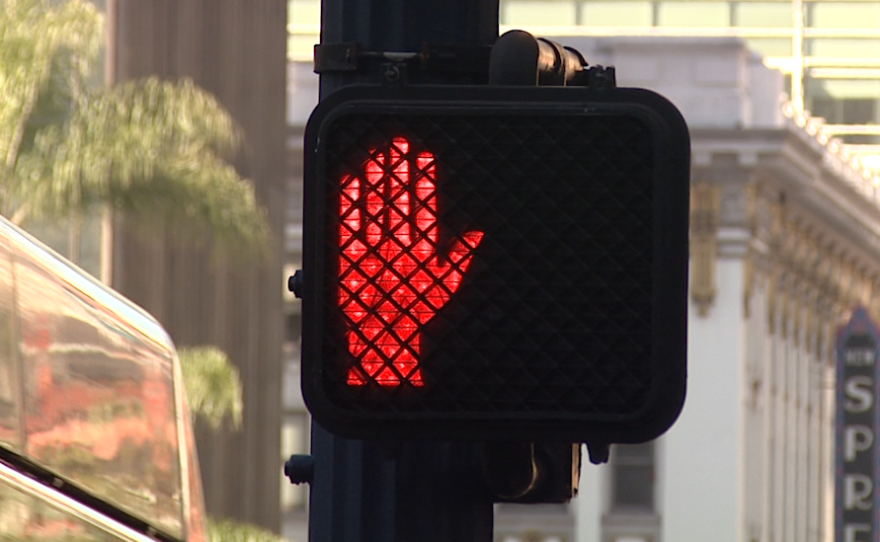It has been nearly a year and a half since the San Diego City Council passed a resolution supporting Vision Zero, a plan to eliminate traffic deaths in the city by 2025. The plan is meant to be ambitious but achievable, requiring nothing short of a dramatic change in the city's culture of fast driving and easy parking.
Yet the official in charge of redesigning the city's streets to make them safer paints the plan's goals as aspirational.
"One fatality is too much," Kris McFadden, director of San Diego's Transportation and Storm Water Department, said in an interview this week. "We should have a goal of zero (traffic deaths). Unfortunately, we know we won't be able to meet that."
The comment does not surprise Kathleen Ferrier, policy director for the nonprofit Circulate San Diego, which initiated the Vision Zero project.
"I don't think the city is taking Vision Zero seriously," she said.
Some of that frustration manifested in a press conference held last month by Circulate San Diego calling attention to what it branded the "Fatal 15" — intersections throughout the city where pedestrians are most likely to be killed or seriously injured, but which lack some basic safety features like "continental crosswalks" or countdown timers.
Ferrier said the greatest area in which the city’s efforts fall short is in redesigning San Diego streets to slow down traffic and improve safety for pedestrians and bicyclists.
"There are no new actions on the engineering side," she said. "It's business as usual."
RELATED: San Diego Presents Watered-Down Redesign Of El Cajon Boulevard
One effort commonly cited by city officials as working toward the Vision Zero goals is the addition of painted bike lanes and highly visible crosswalks when streets are repaved. Officials have said this will also work toward their goal of reducing greenhouse gas emissions by getting more people to bike and walk to work.
Linda Marabian, deputy director of the city's Transportation and Storm Water Department, said this allows the city to work more efficiently.
"As we resurface, we repurpose," Marabian said.
But the usefulness of the practice has its limits: A newly repaved street may be too narrow to add dedicated bike lanes without sacrificing street parking — something the city is reluctant to do. And the city resurfaces streets based on the quality of the pavement, not the street's connectivity to the existing bike network or its need for pedestrian safety improvements. This was noted in a city auditor's report last year on pedestrian safety. City officials say they are implementing the report's recommendations.
The extent to which the city is expanding its bike network is also limited. The mayor's current budget includes $750,000 for "minor bike facilities" — but the funding goes mostly to feasibility studies about future projects, not construction. Of the more than 200 miles of bike facilities counted in the city's bike program in the last four years, less than a quarter were new facilities. The rest were improvements to existing facilities. Only 2.5 miles included physical barriers protecting bicyclists from motorists.

Task force frustrations
Last summer, the mayor's office came out with a Vision Zero strategic plan for the current fiscal year containing a list of action items. The list includes applying for more grant funding, developing a data sharing portal to promote transparency and analyzing the leading causes of crashes and fatalities in the city.
However some of the items on the list began before the city passed its Vision Zero plan. An update to the city's street design manual, for example, was driven by a desire to consolidate the existing manual and its addendums with the city's design standards for storm drains. Marabian said the updated manual would put on paper standards that the city already uses.
The manual update was due to be completed in November 2016, but has since been delayed to this summer. The city denied a Public Records Act request by KPBS to view a draft of the update, saying its disclosure would "discourage candid discussions within the agency and thereby undermine the agency’s ability to perform its functions in putting the record in final form."
Another frustration Ferrier expressed was with the Vision Zero task force, which is made up of advocates and city officials. Ferrier said the meetings have become opportunities for the city to list off its plans, leaving little time for feedback.

"The last meeting we were supposed to start talking about items that would be going into the budget, and that didn't happen," Ferrier said. "The city talked about some educational efforts that they've been thinking about. But they presented it as: 'These are educational efforts that the Vision Zero coalition members can undertake,' rather than the city actually paying for it."
Beryl Forman, marketing and mobility coordinator for the El Cajon Boulevard Business Improvement Association, agreed that the task force meetings were unproductive. She said one particularly irksome meeting was last year when city officials said they had committed $30 million to Vision Zero projects. She said the number struck her as outrageous because it included nearly every single road project happening throughout the city.
"Overall, the effort is not really coming together," she said.
Both Forman and Ferrier were disappointed by the city's planned redesign of a section of El Cajon Boulevard that runs between City Heights and Talmadge. The project maintains most of the street parking on both sides of the boulevard, but it does so at the expense of new bike lanes. The project will include a painted lane for five blocks on one side of the street.
Asked if motorists would have to sacrifice some convenience to meet the city's Vision Zero goals, Marabian's answer was quick: "No, not at all."








